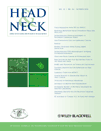Investigation of optimal intensity and safety of electrical nerve stimulation during intraoperative neuromonitoring of the recurrent laryngeal nerve: A prospective porcine model†
Part of this work was presented at the World Congress on Thyroid Cancer (WCTC), Toronto, Canada, August 6–10, 2009, and the First Congress of Asian Society of Head and Neck Oncology (ASHNO), Taipei, Taiwan, September 17–19, 2009.
Abstract
Background
Intraoperative neuromonitoring (IONM) of the recurrent laryngeal nerve (RLN) has recently been more frequently applied in thyroid surgery. However, concerns have been raised regarding the safety and optimal intensity of electrical nerve stimulation.
Methods
Eight piglets were enrolled, and electrically evoked electromyography (EMG) was recorded from the vocalis muscles via endotracheal surface electrodes. The baseline EMG was measured and continuous pulsatile stimulations were performed on the vagus nerve and RLN for 10 minutes. Changes of EMG waveform and cardiopulmonary status were analyzed.
Results
A dose–response curve existed with increasing EMG amplitude as stimulating current was increased, with maximum amplitude elicited on vagal and RLN stimulation at <1 mA. No obvious EMG changes and untoward cardiopulmonary effects were observed after the stimulation.
Conclusions
Electrical stimulation is safe during IONM in this porcine model. Minimal current that required generating the maximal evoked EMG, approximately 1 mA in this study, can be selected to minimize the risk of nerve damage and cardiopulmonary effects. © 2010 Wiley Periodicals, Inc. Head Neck, 2010




